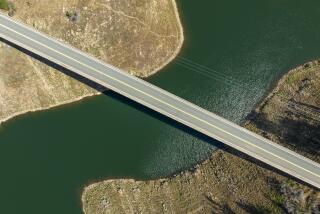There’s No Reason to Celebrate the ‘End’ of the Seven-Year Drought : Water: It’s a serious mistake to think of rainfall in terms of averages and cycles, according to recent and prehistoric data. Scarcity is still our future.
- Share via
Despite Gov. Pete Wilson’s sunny declaration that the state’s seven-year drought is over, California may never be entirely free from drought conditions. A continually growing population, unfavorable court deci sions, demands for stronger environmental legislation, mounting economic and political obstacles to building major new water projects--all portend a future of permanent shortage unless careful management strategies are adapted. Even then we may not have enough water.
Part of the problem is how we think about rainfall in California. This season’s total is well above “average.” But it is a serious mistake to think of it in terms of average and regular cycles of rain. The evidence, both recent and in tree rings dating from prehistoric times, reveals great variation in the state’s rainfall. For example, the average annual precipitation in the Los Angeles area, as determined over the last century, is nearly 15 inches. But this average rests on such rainfall extremes as 19 inches in one year, followed by 6, 11, 14, 40 and 11 inches in consecutive years, respectively.
The long-term record reveals a similar pattern of alternating cycles of severe drought and heavy rain. Studies of tree rings during a 360-year period in California indicate that the longest interval of minimum growth--a reflection of drought--was from 1760 through 1820. Drought in the 1860s was so severe that the cattle population in Los Angeles County declined by more than 70% in two years. By contrast, the decade from 1935 to 1944, with an annual average rainfall in Los Angeles of nearly 19 inches, was a period of maximum growth rarely approached in previous years. Not only is the length of the cycles unpredictable, but parts of the state can be experiencing drought while others are under water.
There is now hope that the water supply will increase as a result of the Reclamation Projects Authorization and Adjustment Act, passed by Congress last October. Among other things, the law allows Central Valley Project suppliers to sell their water to buyers outside the project’s boundaries--good news for water-hungry cities. Yet, the law’s ultimate impact is far from clear. For example, all water sales that involve transfers exceeding 20% of the supply in any district must have the approval of that district. Approval for such water transfers is not likely to come easily, given the intensity of the opposition to the law from Central Valley farm interests. Still, a significant volume of new water will flow to cities, with the overall impact likely to be the increased urbanization of California, which creates demands for more water.
Ground water cannot be counted on to help meet this demand. Over the ages, the ground water in California’s approximately 450 aquifers increased tremendously, enough to put the entire state under 13 feet of water. In modern times, however, overpumping has reduced the volume from approximately 1.3 billion acre-feet to some 850 million acre-feet, of which about one-sixth is readily usable.
Despite the enormity of the ground water reserves, the rate of decline in quantity and quality, as a result of industrial and agricultural pollutants, continues, with some depleted aquifers collapsing, never again to be refilled. Not surprisingly, the volume of water extracted during dry years greatly exceeds the rate of replenishment. What is worrisome is that during the wet years, the rate of ground-water extraction exceeds replenishment by an annual average of 2 million acre-feet, with an even greater overdraft in highly developed urban and agricultural areas.
What makes this situation especially serious is that Southern Californians, despite their many aqueducts, still rely on ground water to meet 40% of their needs, double that amount during periods of drought. For some, the reliance is much greater: the cites of San Bernardino and Riverside get nearly all their water from the ground, and Orange County relies on wells to supply 70% of its water.
What should be done? In California, water-management responsibilities are scattered among at least two major federal agencies, four major state organizations and nearly 1,000 public and private entities at the regional and local levels, with many of their functions overlapping. A coordinating agency to take charge and develop a coherent water policy seems clearly warranted.
Lawmakers must stop making a false distinction between ground water and surface supplies, recognizing they are interconnected and part of the same hydrologic cycle. This would prevent the unrestrained extractions that now encourage despoliation, exhaustion and frequent collapse of aquifers.
California would also benefit from a thorough overhaul of the U.S. system of agricultural subsidies that encourages the cultivation of low-value, water-intensive surplus crops. The growers of such crops are subsidized twice by taxpayers--first, through cheap water, second through federal price supports and supply controls that, in effect, pay farmers to take some of their land out of production. The 1992 reclamation act creates a three-tier pricing system for agricultural water, but it is not a sharp departure from past practices.
Ultimately, however, there is no real alternative to water conservation. In wet years, conservation at a minimum would permit environmental restoration, including the cleaning up and replenishment of abused aquifers. As for dry years, California has experienced droughts lasting 61, 25, 20 and 10 years respectively. We would be foolish to carry on our tradition of regarding cheap, abundant water as a birthright. That myth, dating back to the turn of the century, is all washed up.
More to Read
Sign up for Essential California
The most important California stories and recommendations in your inbox every morning.
You may occasionally receive promotional content from the Los Angeles Times.










